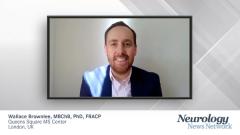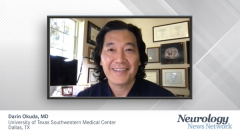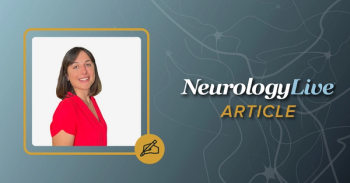
Ozanimod in DMT Naïve vs Experienced Patients with Relapsing Multiple Sclerosis
Dr Gabrielle Macaron reviews data with ozanimod in treatment naïve vs experienced patients with relapsing multiple sclerosis presented at EAN 2022.
Episodes in this series

Gabrielle Macaron, MD: The latest data on ozanimod was recently presented at EAN [European Academy of Neurology Congress]. But before we discuss those data, let’s go over the 2 pivotal phase 3 randomized control trials, RADIANCE and SUNBEAM, which evaluated ozanimod and compared ozanimod at 2 different doses: 0.5 mg and 1 mg of ozanimod hydrochloride vs interferon beta-1a. Both studies were in Nansen Neuroscience [Lecture] in 2019, and both studies have similar results in favor of ozanimod.
The main difference between the 2 trials is duration. RADIANCE was done over 24 months, whereas SUNBEAM was done over 20 months. In both studies, over 1300 patients with relapsing MS [multiple sclerosis], aged between 18 and 55, and with an EDSS [Expanded Disability Status Scale] less than 5 were enrolled. The primary outcome measure was to analyze relapse rate, and this was significantly lower in both ozanimod groups compared with the interferon group. This result was seen in both trials. The secondary outcome measures, such as the mean number of new or enlarging T2 lesions and the number of gadolinium-enhancing lesions, were significantly lower in both ozanimod groups, but more so in the 1-mg group, so the higher ozanimod dose, compared with interferon.
Although both studies were not designed to compare doses, the number of relapses and the number of new lesions on MRIs were lower in the higher dosage of ozanimod. That’s what led to the approval of the higher dose. Ozanimod was also more effective than interferon in decreasing measures: loss of whole-brain volume, loss of cortical gray matter volume, and loss of thalamic volume. SUNBEAM and RADIANCE are the first phase 3 studies to report this reduction in cortical gray matter and thalamic volume loss in MS. That suggests that ozanimod might have an effect on the neurodegenerative component of the disease. This idea is also supported in SUNBEAM, where ozanimod at the higher dosage also had an efficacy or a positive effect on cognitive measures in the trial. Another important result of these trials is that the pooled analysis of RADIANCE and SUNBEAM data on disability progression did not truly show a difference between groups over the study period. That’s important to mention. Maybe we need more time to see this difference.
Another important study that’s directly relevant to the abstract presented at EAN is the DAYBREAK study. This is a single-arm, open-label extension study in patients with relapsing MS who completed any phase 1 through 3 trial of ozanimod. Almost 2500 patients were included and treated with ozanimod at the higher dosage, which is 0.92 mg. That’s the approved dose, which is equivalent to 1 mg of ozanimod hydrochloride, which was evaluated in the phase 3 trials. This open-label extension study had a mean duration of 4 years. For patients who were on ozanimod in the parent trial and then were included in DAYBREAK, it was was around 5 years. In this study, the adjusted annualized reduction rate remained low throughout the study, and 71% of patients remained relapse-free. The number of new or gadolinium-enhancing lesions was also low throughout the treatment period and across the different initial groups. Based on which parent trial they were in and which treatment arm patients were on and regardless of the number, the radiological activity remained low. After switching from interferon to ozanimod, patients had numerically lower annualized relapse rates and a decreasing lesion count during the duration of the extension study.
Now we can move on to the ozanimod data presented at EAN. This conference was held in Vienna, Austria. The abstract is titled, “Efficacy of Ozanimod in Disease-Modifying Treatment, Naïve vs Experienced Patient With Relapsing Multiple Sclerosis.” This was an exploratory analysis. The others evaluated the efficacy of ozanimod in patients who were treatment naïve before enrolling in the pivotal trials vs those who were previously treated with another disease-modifying therapy and who received interferon during the parent trial or the higher dose of ozanimod, whether it was SUNBEAM or RADIANCE, and then received ozanimod in DAYBREAK. Fifteen hundred patients were included in this open-label extension study. Those were patients who initially entered RADIANCE or SUNBEAM, not patients who were in the phase 1 or 2 trials. Of those enrolled patients, less than a third were previously treated with another disease-modifying therapy. Mostly that was interferon and glatiramer acetate—platform therapies and the rest—and more than two-thirds were treatment naïve. In both groups, ozanimod was effective in maintaining a low annualized relapse rate and a low mean number of new T2- enhancing lesions.
In patients who were on interferon beta-1a during the parent trial, the annualized relapse rate decreased significantly after switching to ozanimod in the extension study. This happened in both groups, so those who were treatment naïve and those with disease-modifying therapy experienced prior to enrolling in the parent trial. This annualized relapse rate was numerically lower in the treatment-naïve group in both the parent trial and the open-label extension study, but it’s important to note a potential bias: treatment-naïve patients might have a milder and less active disease independently of treatment. In patients who were continuously on ozanimod since the beginning of the parent trial, the annualized relapse rate remained low in the open-label extension study and was numerically lower in disease-modifying therapy-naïve patients as well. The same bias applies here. The number of gadolinium-enhancing lesions was numerically higher in the treatment-experienced group at the end of the parent trials, but in the open-label extension study—after switching to ozanimod for patients who were on interferon, whether or not they were exposed to treatment at baseline—this number decreased significantly in both groups. This also applies to the mean number of new T2 lesions.
Transcript edited for clarity
Newsletter
Keep your finger on the pulse of neurology—subscribe to NeurologyLive for expert interviews, new data, and breakthrough treatment updates.
































